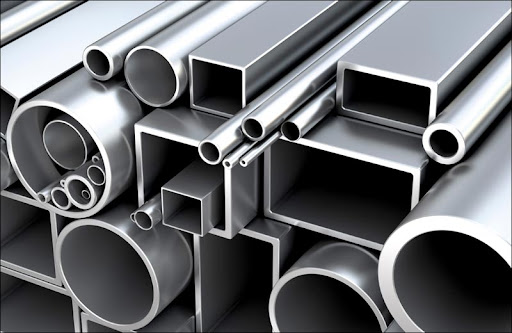According to production method
Steel pipes can be divided into two categories according to production methods: seamless steel pipes and welded steel pipes. Welded steel pipes are referred to as welded pipes for short.
1. According to production methods, seamless steel pipes can be divided into: hot-rolled seamless pipes, cold-drawn pipes, precision steel pipes, hot-expanded pipes, cold-spinned pipes, and extruded pipes.
Bundles of steel pipes
Bundles of steel pipes
Seamless steel pipes are made of high-quality carbon steel or alloy steel, and are divided into hot-rolled and cold-rolled (drawn).
2. Welded steel pipes are divided into furnace welded pipes, electric resistance welded (resistance welded) pipes and automatic arc welded pipes due to their different welding processes. Due to their different welding forms, they are divided into two types: straight seam welded pipe and spiral welded pipe. It is round welded pipe and special-shaped (square, flat, etc.) welded pipe.
Welded steel pipes are formed by welding steel plates rolled into a tube shape with butt seams or spiral seams. In terms of manufacturing methods, they are divided into welded steel pipes for low-pressure fluid transportation, spiral seam electric welded steel pipes, direct coil welded steel pipes, and electric welded pipes. Seamless steel pipes can be used for liquid pressure pipes and gas pipes in various industries. Welded pipelines can be used for water pipelines, gas pipelines, heating pipelines, electrical pipelines, etc.
By material
Steel pipes can be divided into carbon pipes, alloy pipes, stainless steel pipes, etc. according to the pipe material (that is, steel type).
Carbon tubes can be divided into ordinary carbon steel tubes and high-quality carbon structural tubes.
Alloy tubes can be divided into: low alloy tubes, alloy structural tubes, high alloy tubes, and high strength tubes. Bearing tubes, heat-resistant and acid-resistant stainless tubes, precision alloy (such as Kovar) tubes and high-temperature alloy tubes, etc.
Classified by connection method
Steel pipes can be divided into smooth pipes (with no threads on the pipe ends) and threaded pipes (with threads on the pipe ends) according to the connection method of the pipe ends.
The wire tube is divided into: ordinary wire tube and tube end thickened wire tube.
Thickened wire tubes can also be divided into: external thickening (with external threads), internal thickening (with internal threads), and internal and external thickening (with internal and external threads).
According to the thread type, the threaded tube can also be divided into: ordinary cylindrical or conical thread and special thread.
In addition, according to user needs, wire pipes are generally delivered with pipe joints.
According to the characteristics of plating
Steel pipes can be divided into black pipes (not plated) and coated pipes according to the characteristics of surface coating.
Coated pipes include galvanized pipes, aluminum-plated pipes, chrome-plated pipes, aluminized pipes and other alloy-layer steel pipes.
Coated pipes include outer-coated pipes, inner-coated pipes, and inner-outer coated pipes. The commonly used coatings are plastic, epoxy resin, coal tar epoxy resin and various glass-type anticorrosive coating materials.
Galvanized pipe is divided into: KBG pipe, JDG pipe, threaded pipe and so on.
By purpose
1. Pipes for pipes. Such as: seamless pipes for water, gas pipes, steam pipes, oil transportation pipes, and oil and natural gas trunk lines. Agricultural irrigation water taps with pipes and sprinkler irrigation pipes, etc.
2. Pipes for thermal equipment. Such as boiling water pipes and superheated steam pipes for general boilers, superheating pipes, large smoke pipes, small smoke pipes, arched brick pipes and high temperature and high pressure boiler pipes for locomotive boilers.
3. Pipes for machinery industry. Such as aviation structural tubes (round tube, oval tube, flat oval tube), automobile half-shaft tube, axle tube, automobile and tractor structural tube, tractor oil cooler tube, agricultural machinery square tube and rectangular tube, transformer tube and bearing Tube and so on.
4. Pipes for petroleum geological drilling. Such as: oil drilling pipes, oil drill pipes (kelly and hexagonal drill pipes), drill stems, oil tubing, oil casing and various pipe joints, geological drilling pipes (core pipes, casings, active drill pipes, drill stems) , Press hoop and pin joints, etc.).
5. Tubes for the chemical industry. Such as: petroleum cracking pipes, chemical equipment heat exchangers and pipes, stainless acid-resistant pipes, high-pressure pipes for fertilizers, and pipes for transporting chemical media.
6. Other departments use management. Such as: container tube (high-pressure gas cylinder tube and general container tube), instrument tube, watch case tube, injection needle and medical device tube, etc.
According to the section shape
There are many steel grades and specifications of steel pipe products, and their performance requirements are also various. All these should be differentiated according to user requirements or changes in working conditions. Generally, steel pipe products are classified according to cross-sectional shape, production method, pipe material, connection method, coating characteristics and use.
Steel pipes can be divided into round steel pipes and special-shaped steel pipes according to their cross-sectional shape.
Special-shaped steel pipes refer to steel pipes with various non-circular cross-sections.
The main ones are:
Square tube,
Rectangular tube,
Oval tube,
Flat oval tube,
Semicircular tube,
Hexagonal tube,
Hexagonal inner tube,
Hexagonal tube with unequal sides,
Equilateral triangle tube,
Pentagonal plum tube,
Octagonal tube,
Convex tube,
Double convex tube,
Double concave tube,
Multi-concave tube,
Seed-shaped tube,
Flat tube,
Rhombus tube,
Star tube,
Parallelogram tube,
Ribbed pipe,
Drop tube,
Inner finned tube,
Twisted pipe,
Type B tube,
D type tube and multilayer tube, etc.
According to the shape of the longitudinal section, steel pipes are divided into equal-section steel pipes and variable-section steel pipes. Variable cross-section (or variable cross-section) steel pipe refers to a steel pipe whose cross-sectional shape, inner and outer diameter, and wall thickness along the length of the pipe change periodically or non-periodically. It mainly includes: outer tapered tube, inner tapered tube, outer stepped tube, inner stepped tube, periodic section tube, corrugated tube, spiral tube, steel pipe with fins, and gun barrel with double wire.
Post time: Jul-29-2021







